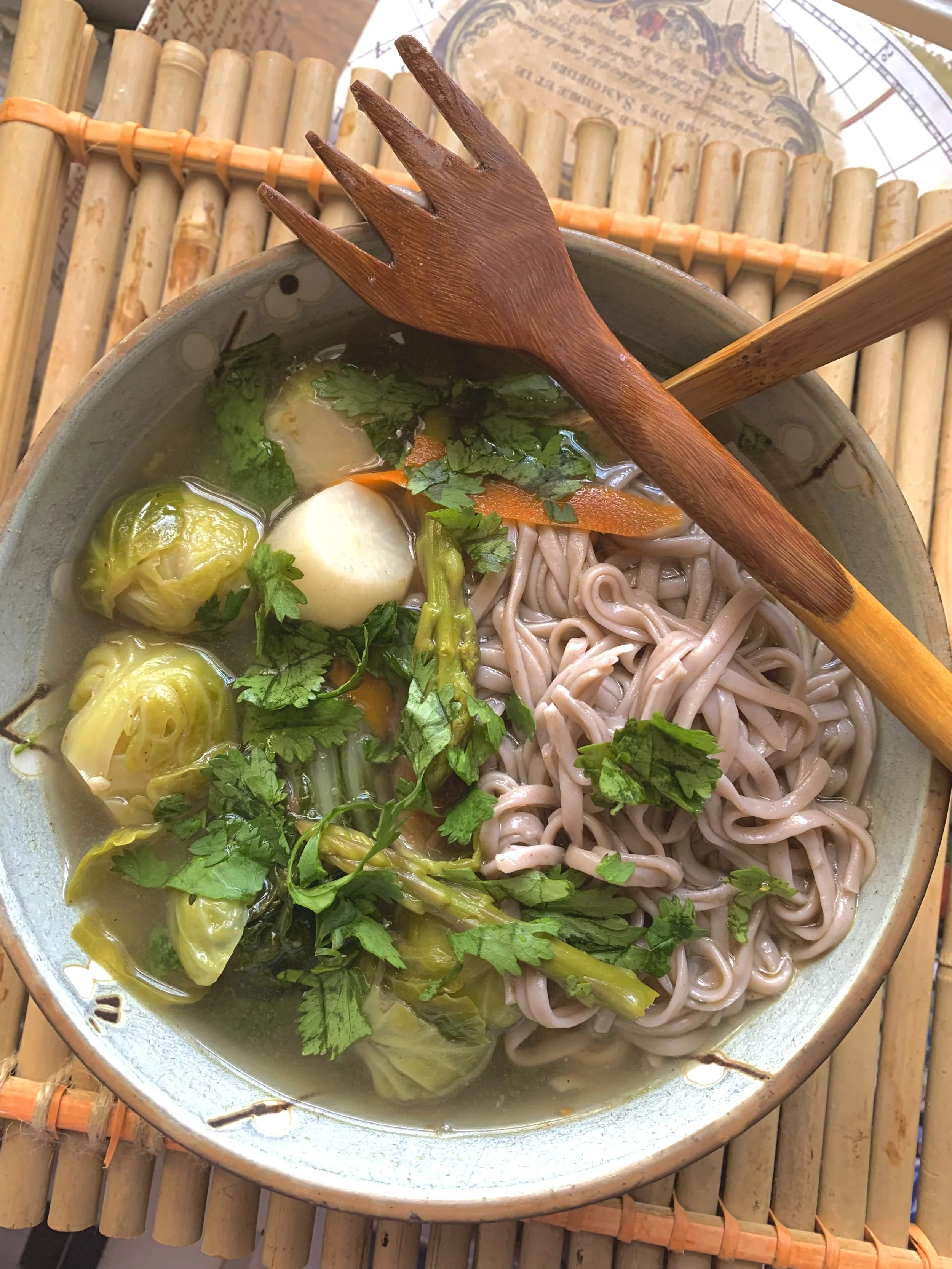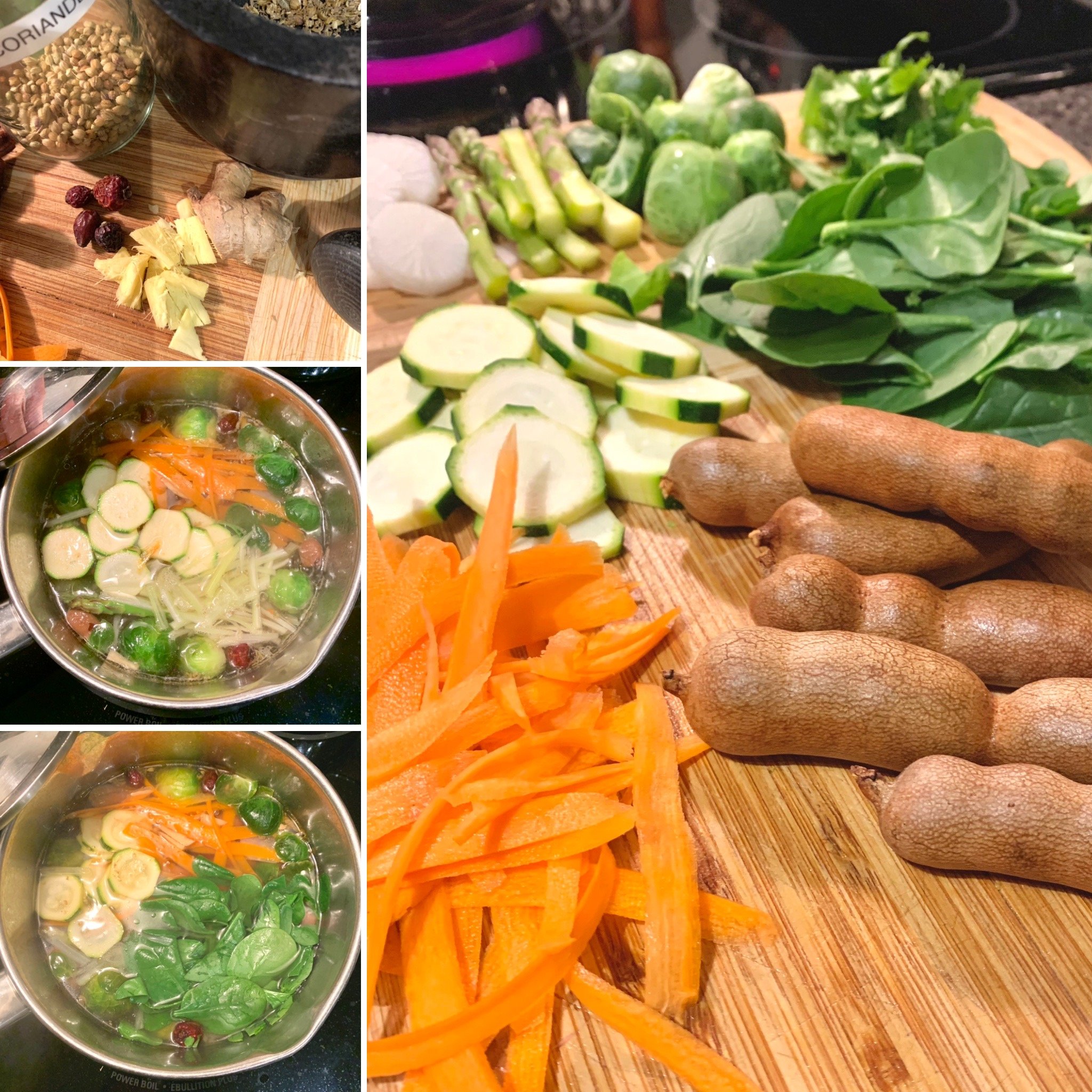Soba Noodle Soup with Ginger, Tamarind & Rosehips
Welcome to my Ayurveda & Yoga blog! I’m Evangeline and I’m an RMT and holistic health coach. I started my blog during covid to stay connected to my clients and share my love of cooking healthy, AYURVEDIC INSPIRED meals.
Ayurvedic cooking is a conscious approach to preparing and cooking tasty, nutritious, balanced meals using spices and herbs, and taking into consideration the external conditions such as the season and time of day, in addition to how you are feeling.
Fresh tamarind is a key ingredient in “sinigang”, a hearty Filipino sour, tangy soup of vegetables with chicken, meat or fish. Childhood memories of my mom cooking sinigang was the inspiration behind this soup. I really had no idea where this soup was going when preparing it, but the overarching principle of balance guides my cooking. I think that is one of the most wondrous of surprises in the kitchen, when you are simply inspired and you reach for what you have on hand and make a meal out of it.
The timeless knowledge of Ayurveda informs my cooking and in this recipe, and others the health benefits of the ingredients are briefly described. It is deeply understood in Ayurveda that proper digestion of food is very important for good health as many diseases can be traced back to improper digestion. This savoury, tangy soup supports your digestive system, and is gentle and soothing with a balanced array of spices. As this was prepared as a light dinner, add your choice of protein if you wish. Enjoy!
Whole rosehips, ginger root, and fresh tamarind strands.
Fresh tamarind is a key ingredient in “sinigang”, a hearty Filipino sour, tangy soup of vegetables and meat or fish. Childhood memories of my mom cooking sinigang was the inspiration behind this soup.
Ayurvedic Profile of Ingredients
Ginger - ignites digestive agni; aids in digestion; helps with arthritis
Tamarind - tangy, sweet taste; supports metabolism and elimination
Rosehip - tangy, mild sour taste; nurtures the soul; pacifies sadhaka pitta
Coriander - balancing and cooling to the liver and other organs and systems protecting it from acidity with its alkalizing effetc; helps remove toxins and heavy metals through the urinary tract
Cumin- helps with absorption and assimilation of nutrients including water; helps with fat metabolism; stimulate digestive fire, jataragni- stomach agni, and cleans metabolic burner without overheating the metabolic system; burns ama (a toxin made in the body from undigested food particles).
Turmeric- one of the most extensively researched spices; anti-oxidant, anti-inflammatory; anti-bacterial and anti-viral; not to be taken raw or made into a tea as it is heating to the liver; cook with it as it needs fats to best activate its properties; known as “a friend to the liver”; detoxes the liver and the blood; helps break down fat in the liver; support the excretion of bile which breaks down fat in the colon, which in turn increases agni in the apana vata area
Black Peppercorns- opens the micro and macro channels and vessels; supports the kidney channels; increase bio-availability of turmeric’s active compound, curcumin, by 2,000%.
Fennel seeds- coordinates the function of other spices and herbs; can be used in many ways- in cooking, in tea, chewed after a meal, and in formulations; enhances agni/digestive fire without heating; has a sweet taste, and also cools digestive fire if too high; balances the heating effect of turmeric; supports estrogen production, thus caution with usage if you have high estrogen.
Soba Noodle Soup with Ginger, Tamarind & Rosehips, garnished with Cilantro
Soba Noodle Soup with Ginger, Tamarind & Rosehips
Yields: 2 Large Bowls of Soup
Prep Time: 15 minutes
Cooking Time: 15 minutes
IngredientS
Broth for 2-3 servings
½ tsp ghee or sesame oil
1 Tablespoon ginger root
6 whole rosehips crushed
1 tsp ground fennel
1 tsp ground coriander
¼ tsp ground cumin
⅛ tsp ground pepper
⅛ tsp turmeric powder
4 tamarind strands
¼ tsp soma salt or sea salt
4 cups water or vegetable broth
Vegetables
A handful per person of Brussels sprouts, carrot ribbons, zucchini, asparagus, radish, spinach, bok choy. If digestion is sensitive, have only 1 or 2 varieties of vegetables. I have also made this soup with bok choy as the only vegetable—simply delicious!
Noodles
About 50 grams uncooked per person. Shown here is 100% buckwheat noodles
DIRECTIONS
Prepare your vegetables. There is quite a variety of vegetables in this soup, so just about a handful of each vegetable for each person and a bit more, considering your appetite and digestive needs.
In a medium or large size pot, boil water for the buckwheat noodles.
Heat ghee or sesame oil on medium heat in another medium size pot and add ginger root, crushed rosehips and spices and combine until aroma is released. Add water, turn heat up to high, and let it come to a boil for 5 minutes.
Add vegetables to the soup base. Turn heat down to medium. Cook harder vegetables first— Brussels sprouts, daikon radish, and carrot ribbons and cook for a couple of minutes covered with a lid. Then add zucchini, followed by asparagus, cover and cook for another couple of minutes. Add tamarind pods and leafy greens last, cover with a lid once more, and turn heat down to medium-low and cook until greens turn a bright, glossy green. At the end of cooking add salt and stir and keep on low heat.
Halfway while vegetables are cooking, in another pot, boil water and cook soba noodles for about 5 minutes. Drain and run a bit of cool water over noodles.
Transfer soup and vegetables into each bowl, and top with soba noodles. Serve immediately.
Options for garnish; cilantro, splash of lime, toasted sesame seeds
Enjoy!
References
Vaidya R. K. Mishra- Notes from Shaka Vansiya Ayurveda Courses, Practicum, Conferences and Lectures, 2003-2015
David Frawley, Vasant Lad, The Yoga of Herbs, 2001



